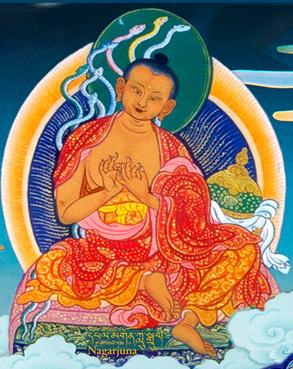Collection of Praises: Difference between revisions
Jump to navigation
Jump to search
No edit summary |
mNo edit summary |
||
| Line 1: | Line 1: | ||
[[Image:Nagarjuna17.JPG|frame|'''Nagarjuna''']] | [[Image:Nagarjuna17.JPG|frame|'''Nagarjuna''']] | ||
'''Collection of Praises''' (Tib. བསྟོད་ཚོགས་, tö tsok, [[Wyl.]] ''bstod tshogs'') - One of the main categories of [[Nagarjuna]]'s writings. | '''Collection of Praises''' (Tib. བསྟོད་ཚོགས་, ''tö tsok'', [[Wyl.]] ''bstod tshogs'') - One of the main categories of [[Nagarjuna]]'s writings. | ||
Towards the end of his life, acting on advice from [[Tara]], Nagarjuna returned to Southern India and dwelt at a place called Mount Splendour, where he gave extensive teachings on both the Sutras and Tantras, and composed many more texts. These writings, known as the Collection of Praises, are likened to Buddha's third turning of the Wheel of Dharma. | Towards the end of his life, acting on advice from [[Tara]], Nagarjuna returned to Southern India and dwelt at a place called Mount Splendour, where he gave extensive teachings on both the Sutras and Tantras, and composed many more texts. These writings, known as the Collection of Praises, are likened to Buddha's third turning of the Wheel of Dharma. | ||
Revision as of 18:19, 21 November 2017

Collection of Praises (Tib. བསྟོད་ཚོགས་, tö tsok, Wyl. bstod tshogs) - One of the main categories of Nagarjuna's writings.
Towards the end of his life, acting on advice from Tara, Nagarjuna returned to Southern India and dwelt at a place called Mount Splendour, where he gave extensive teachings on both the Sutras and Tantras, and composed many more texts. These writings, known as the Collection of Praises, are likened to Buddha's third turning of the Wheel of Dharma.
The Texts
The texts in this collection include: